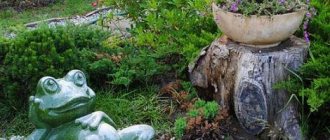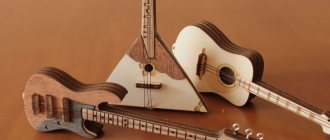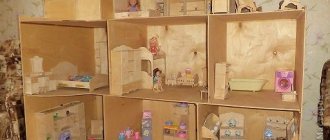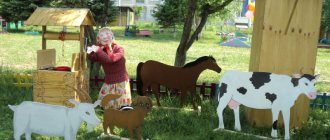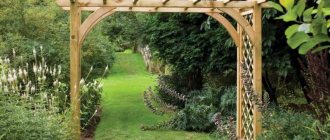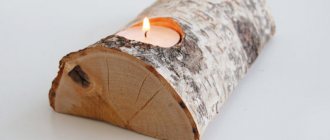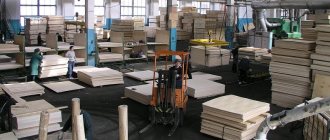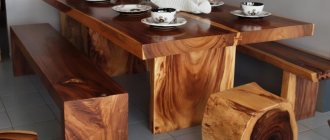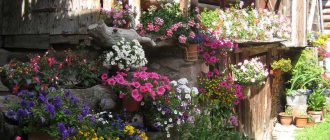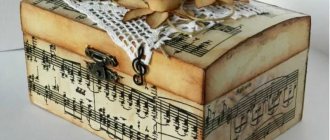A birdhouse made of plywood is an excellent opportunity to simultaneously take care of birds and practice carpentry. A homemade bird house can decorate the balcony of a multi-storey building or a garden plot. Birdhouses can be made from a variety of materials, but most often they are made from wood or plywood. The work process is simple, you just need to follow the rules and recommendations.
Birdhouse made of plywood
Preparation of the workplace
As usual, the first thing you need to do is equip your workplace where you will work. The rules are not complicated: there should be no unnecessary things on the table, all the tools should be in their place and at hand. Not everyone has their own desktop, and you’ve probably already thought about creating one. Making a table is not difficult; choosing a place for it in the house is more difficult. A good option is an insulated balcony, where you can start working on your craft at any time. If you have a specially equipped room with a workbench, then you are lucky. In a separate article you can read about preparing a desktop where I tried to describe in as much detail as possible the entire process of creating it. After you have completed the process of creating a workplace, you can proceed directly to your future craft.
Features of work
Different materials can be used to make birdhouses, from wood to large plastic bottles. But it is much easier to do this from plywood. First you need to draw a diagram of the future structure to find out the dimensions of the roof and walls. You will need a finished drawing of a birdhouse.
Making a birdhouse with your own hands
At the preparatory stage, it is also necessary to think about what species of birds the structure will be designed for. After all, birds differ in size from each other, so if the bird house is intended for starlings, then the hole needs to be made small, like the structure itself. Larger birds, such as wagtails, require a larger house.
Birdhouse manufacturing plan
The finished birdhouse should not only be easy to manufacture, but also comfortable for birds, so its design should include a removable roof and a reliable bottom. We must not forget about the entrance - a special hole for birds through which they enter and exit the house. A removable roof is needed so that when it is removed, you can clean the birdhouse. Removing the roof can also add bird food or change the water.
DIY birdhouse
Plywood selection
The main elements will fit on A4 plywood, since some parts need to be made in several copies, you will need several blanks. The thickness of the plywood should be from 2.5 to 3 mm, and depending on the thickness, sawing should be done along the internal or external contour, this is important for the grooves into which the elements of the craft are inserted. Before transferring the drawing to plywood, sand the workpiece with coarse sandpaper and then with fine sandpaper. Wrap a block of wood in sandpaper and then start sanding. Sand the prepared plywood along the layers, not across. A well-polished surface should be flat, completely smooth, glossy-matte in the light and silky to the touch. Pay attention to grain placement, knots, dents and other imperfections. Quality and color. If the plywood is not of very high quality and delaminates when sawing, read the recommendations for eliminating plywood delamination.
General information
A birdhouse is a small home for birds, which especially helps them in the spring. But there are other useful aspects of birdhouses made of plywood or other materials:
- if there is at least one birdhouse at the dacha, the owner will have the opportunity not only to observe the life of small birds, but also to enjoy their sonorous singing;
At what height should you hang a birdhouse?
- birds living in the garden will be able to protect the trees from various pests;
- The manufactured birdhouse is not only a house for birds, but also a decorative element for a summer cottage. Of course, this requires a more creative approach to the design of a wooden structure.
A birdhouse on the site has a number of advantages.
The procedure for making a “bird house,” especially if a simple design was chosen as the project, is quite simple. Achieving success requires desire, diligence and a little free time. Then you just need to follow the instructions.
Parents and their children can build a birdhouse in a few hours if they take note of the recommendations from this review
Transferring the design to plywood
You need to translate the drawing accurately and carefully: secure the drawing using buttons, double-sided masking tape, or simply hold it with your left hand. Check if the drawing fits the dimensions. Arrange the individual parts so that you can use the plywood sheet as economically as possible. There is no need to rush, because your future craft depends on the drawing. If you are short on time, then to speed up the translation process you can use the technique of quickly translating a drawing; for this, I suggest that you read the article in the tips section: Drawing technology.
Types of birdhouses
There are many different designs of bird houses, differing in size, shape and complexity of manufacture. But it is worth highlighting the most common species that can most often be seen on trees.
Types of birdhouses
Table. Main types of birdhouses.
| Birdhouse name, photo | Description |
| Titmouse | A classic birdhouse design designed to house small birds. We are talking about tits, sparrows and small owls. Chickadees attach themselves to trees at great heights. |
| Poluduplyanka | A small house designed for songbirds such as redstarts, robins and wagtails. The design has a large hole, larger in size than the hole of the titmouse. |
| flycatcher | A small closed structure with an opening designed for small birds. The flycatcher is significantly inferior to other types of birdhouses in size. |
| Duplyanka | An artificial bird nest made from knocked down boards or hollowed out from a small piece of wood. The product is intended for birds such as owls and jackdaws. |
| House "rhombus" | Another type of birdhouse, made in the shape of a diamond. As a rule, such houses are not nailed to a tree, but are suspended from a branch with small ropes. The “diamond” house is made for rogues. |
| Saraichik | A simple rectangular structure made of wood or plywood. Reminds me of a shoe box. The sheds are intended for wagtails. |
Note! Before starting the work process, you need to study several design options and choose the most suitable one. Only after this can you think about the work plan and prepare the necessary materials.
Cutting out a plywood box with a jigsaw
There are many rules for cutting, but you need to rely on the most common ones. First you should cut out the internal elements and then start cutting out the outline. There is no need to rush when cutting. The main thing is to always keep the jigsaw straight at a 90-degree angle when cutting. Saw out the parts along precisely marked lines. The movements of the jigsaw should always be smooth up and down. Also, do not forget to monitor your posture. Try to avoid bevels and unevenness. If you go off the line while cutting, don't worry. Such bevels and irregularities can later be removed using a flat file or “coarse-grained” sandpaper.
Making a birdhouse
As noted earlier, the work process cannot be called complex, especially if everything is done according to a finished drawing. You just need to follow the step-by-step instructions below.
Drawing of the future birdhouse
Step 1. Measure the dimensions of the two side walls of the birdhouse and the floor, and then use a jigsaw to cut these pieces.
Side walls are cut out
Step 2 . Apply a small amount of glue to the surface of the joints and press the plywood sheets to allow the liquid to dry. Secure the connections with small nails or self-tapping screws.
Fastening the bottom of the structure
Step 3. Slope the roof of the birdhouse so that the back wall fits snugly against all parts of the structure.
Making a birdhouse roof
Step 4: Attach the cut roof to the rest of the structure. As before, use construction adhesive and nails.
The roof is attached to the structure
Step 5: Drill a large hole in the front wall of the birdhouse to allow different birds to enter. The inlet diameter is 30mm, although you can change the dimensions slightly if desired.
A large hole is drilled
Step 6 . Place the front wall of the birdhouse with the finished hole in place, nailing it on both sides.
Front wall installed
Step 7: Drill two small holes in the bottom of the front panel and insert two eye bolts. The distance between them should be 20 mm.
Eye bolts are inserted
Step 8. Wrap the working surface of the pliers with tape, and then bend the thin copper wire at a right angle. To do this you need to use a vice. Select the wire so that its diameter is less than the inner diameter of the eyebolt rings.
A vice is used for work
Step 9. Place the bent wire in place, that is, in the holes of the eye bolts, so that the bent part is on top. Drill a hole in the bottom plate to suit the size of the wire.
A hole is drilled at the bottom
Step 10 . Drill one hole in each corner of the back wall to attach the finished structure to the wood.
Holes in the corners of the rear wall
Step 11 . Now you can nail the finished birdhouse to the tree or glue it to create a new birdhouse.
The structure is almost ready
Step 12 . Paint the plywood product any color you like. For this, it is advisable to use water-based paints, because they protect the wood and are environmentally friendly.
Painting a birdhouse
Step 13 . The plywood birdhouse is completely ready and can be installed on a tree.
Ready birdhouse
Step 14: To avoid damaging the wood when securing the birdhouse, use a clothesline to thread it through the holes in the back wall. Now the product can be hung on a tree trunk and the leash can be tightened. The birds can now move into their new home.
Birdhouse mounted on a tree
Decorating a plywood house
Once the bird house is built, it still needs to be decorated. This is a simple and very interesting process, because you can use your imagination when decorating. Therefore, such a process requires ingenuity and, most importantly, inspiration. There are several interesting design options for a birdhouse made of plywood . Below are the brightest of them.
Building a birdhouse is a noble undertaking
- Paint the body of the birdhouse not in one, but in several colors at once, thereby making the structure more beautiful . For example, the roof and bottom of a birdhouse can be painted dark, and the remaining parts light. Here you need to show your imagination. If possible, the product can be decorated with drawings.
- Decorate the roof of your birdhouse in an unusual way . Many craftsmen add a rural touch to the design of a bird house by gluing hay to the roof. You can also cover the roof with small rope flagella. It will look very impressive.
- Use a jigsaw to cut out different patterns from the plywood, which can eventually be glued to the sides of the birdhouse . Each master chooses the style and size of the carved jewelry himself.
- Make a cute little fence using Popsicle sticks or small twigs . Provide a previously made birdhouse with a finished fence. You can also add steps or small decorative windows to make the birdhouse look like a real home.
In just a few hours, a craftsman without professional carpentry or construction skills can build a simple birdhouse
Unusual birdhouses
The right combination of imagination and skill will turn an ordinary birdhouse into a real palace for birds to live in, with which you can decorate your summer cottage. After all, you can find many original ideas on the Internet! You just need to set aside some free time and get to work. You can involve your children in this process to turn work into a fun game.
What tools and materials will be needed
Making a box will not require any special carpentry skills; you will only need to select high-quality materials. Plywood is perfectly processed, but to build a birdhouse it is best not to use waterproof material; it reeks of phenol and bakelite varnish, which always irritates birds. The optimal solution would be ordinary plywood sheets painted with acrylic or oil paint on drying oil.
The list of tools is quite short:
- Electric drill or benchtop drilling machine with a set of drills and one cylindrical cutter;
- Jigsaw or hand saw;
- Carpentry marking corner;
- A block with sandpaper glued on;
- Hammer, nails, screws.
For decorative finishing, you can use whatever is at hand. In some cases, remnants of veneer, bark, branches, and peeled roofing shingles are used. A plywood box can be lined with slab scraps or any natural materials. Or simply sand the walls and coat them with water-repellent impregnation.
What should you not make birdhouses from?
Not all materials can be used to assemble birdhouses. Let's look at the main materials that should be avoided first.
Juice packaging
Despite the fact that tits and sparrows are very small birds, they will not have enough space to create a nest in a cramped juice box. Therefore, if the birdhouse is made from a two-liter box, then the birds will be able to fit there, but the chicks will not be hatched. If you still want to make something useful for birds from juice packaging, then make a regular feeder with an open design.
Juice box bird feeder
If the bird does lay eggs inside the bag, they will overheat due to the foil, which will accumulate solar heat. This will lead to the death of the chicks. Therefore, even if you have suitable bags or boxes at hand, it is not recommended to make a birdhouse out of them. This idea should be abandoned, thereby preserving the health of the birds.
Plastic
It is not recommended to use transparent plastic to create a birdhouse, since in such a house the birds will not be able to feel completely safe and private. On sunny days, light will penetrate into the house, so the chicks will become easy prey for predators. It is worth noting that when exposed to high temperatures, plastic can release harmful substances that have a negative impact on the health of chicks.
Hanging products from bottles for bird feeders are made with just a couple of cuts in the base of the bottle
Blueprints
A feeder is created for one purpose - to feed the birds. The design is so simple that there is no point in developing a full-fledged drawing.
For crafts there are no strict requirements regarding shape and size. These parameters are determined individually based on the available material.
However, it is also impossible to build a feeder that is too large or small. It will cause discomfort to the birds and the owner himself during maintenance.
It is optimal to maintain the width, length and height within the range of 250-300 mm. For clarity, several diagrams of the simplest feeders are presented. Such houses are most often cut out of plywood.
A standard square-shaped house is complicated by a hipped roof
The blind ends of the house with a gable roof protect birds from the freezing wind in winter
In a simplified scheme, the gable roof of the house is fixed to racks of slats
What to paint with?
Coloring adds aesthetics to the craft and protects the plywood from moisture. However, birds do not like bright colors. They scare them away. The feeders are painted in natural shades of blue and green. Classic white or gray color is acceptable.
If you want patterns, it is better to draw leaves, flowers or an image of a bird. Safe acrylic paints are used for painting. Enamels with chemical solvents are not used, they are toxic to birds.
Acrylic paints are used for painting. Can be mixed with PVA glue. Painting with such a mixture will create an additional protective layer from moisture in the form of a film.
Advice! It is better not to paint the roof, but to cover it with moisture-resistant material.
Advantages and disadvantages
When making a feeder for your feathered friends, you first need to take into account the climate in your region of residence.
Where precipitation is rare and the weather is mostly windless and partly cloudy, the simplest and lightest structures can be built.
But in rainy, sunny and windy regions, preference should be given to denser materials, and the feeders themselves should be equipped with walls and a lid.
Making bird houses from plywood has its advantages and disadvantages.
Let's look at the pros first:
- Material strength, wear resistance . Plywood in its structure is considered a fairly strong material, since each layer is laid in such a way as to compensate for some of the defects of the previous one. As a result, the panels are very hard and resistant to mechanical damage.
- Availability . You can buy plywood at any hardware store, and at very affordable prices. And since it is not at all necessary to use a large leaf to create a feeder, setting up a bird house will cost even less.
- Ease of processing . Plywood is easily cut and processed with the most common tools, and even the most inexperienced craftsman can handle it. It is noteworthy that, unlike solid wood, plywood can be cut in a variety of directions without fear of cracks.
- Versatility . Plywood is easy to bend, it can be given a rounded shape and small elements can be cut out of it. Therefore, when creating a feeder, you can take any diagrams and drawings as a basis, and put into practice any idea you like.
However, it was not without its shortcomings. The disadvantages of plywood include its vulnerability to bad weather.
At high humidity it deteriorates quite quickly, so this design is unlikely to last longer than one cold season.
The situation is complicated by the fact that the parts of the house are in most cases secured with glue rather than mounted on nails.
Frequent rain weakens the adhesive joint. However, this drawback can be leveled out if the feeder is covered with a special sealant, and fixation with glue is combined with the use of screws. This will extend the life of the product, but even in this case, after a year you will have to update the bird house.
